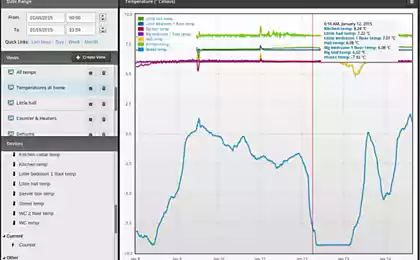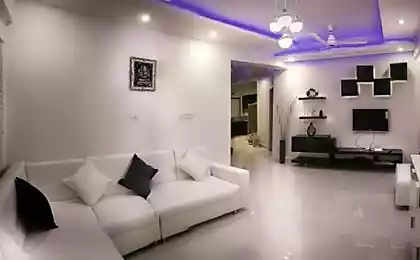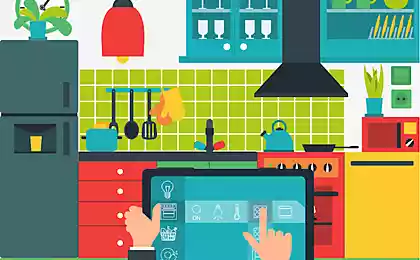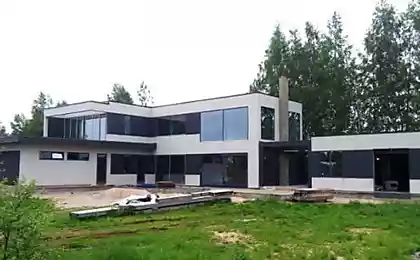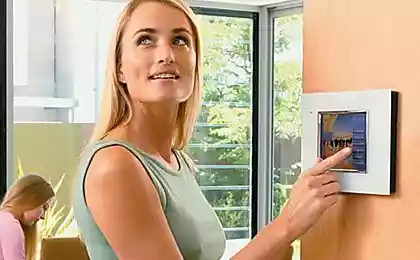592
Smart house for Chicken little
Gadget from the Master kit can increase the fecundity of the chickens in the winter stabling period.
The Master kit came the question, is there any device for modulating on and off light in the coop in the winter? It turns out that if you just switch off the light, the chickens will stay and sleep (and shit) where I was, because in the dark they are very bad and do not find their usual place. Began to study the subject and I came across this article on country living. It turns out that in addition to the artificial sunset them in the winter still need the extended daylight hours, and changing the color scheme, you can control the mood, well-being, growth of the young. To keep the lights on (the benefit of energy saving light bulbs) is also impossible. If the author does not "nightmare", the problem with lighting is quite serious. Came from...

Remembered Watch real-time load management for 4 channels — MP350. Did it to control the watering of the vegetable garden on the schedule. Then wrote another firmware to control the led strips. And with this firmware our device is well suited for "smart home".
Use the following features from:
mode sunrise/sunset allows for 30 minutes of very slow to turn on and off lighting
— the schedule allows you to set the desired start time of the sunrise and sunset
— three channel use for connecting led RGB strips, each color on its own channel
— adjust the brightness for each channel allow to obtain the desired brightness and color
the fourth channel is use to control additional lighting, if necessary.
The last paragraph will explain. Illumination from the led strip may not be sufficient, chicken coops are great. So we organize another channel to activate the main light, through a relay. The logic is this: the dawn begins – slowly gaining brightness LEDs and when they peaked, turn on the main light. Sunset begins in reverse order. First turn off the main lights (the first call for chickens) behind him began to fade gradually led.
In set hours there is a remote control with which you can adjust the desired brightness and hue. After you did the setup necessary to preserve, linking it, for example, a button "1" on the remote. Let's call it "setup 1". Only you can save and use 6 brightness settings and color tones
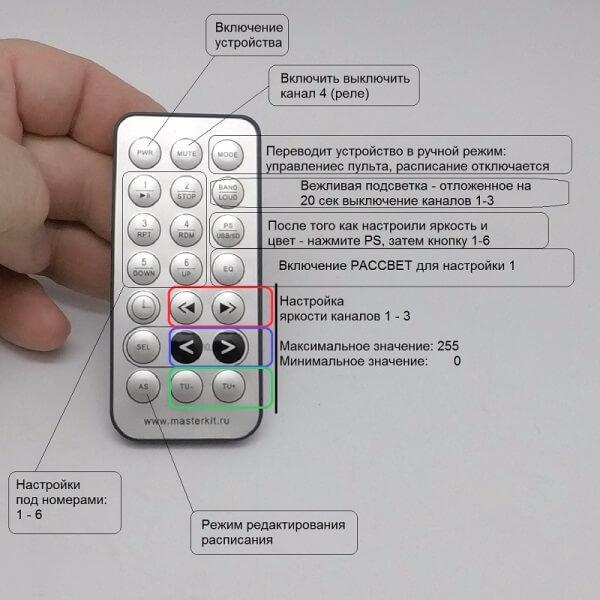
The schedule is easier to edit on the computer in any text editor such as NotePad. The file is a set of rows with time values and commands that should be executed at this moment. It is a text, but must save it with the extension .shd

Next, using a simple free program schedule is recorded in the module.
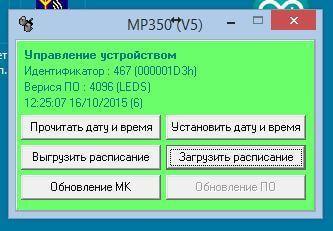
In addition, the program allows you to correctly set the clock and to update the firmware, or replace it with the old version — automatic watering the garden. That is, the device a zealous owner will work in summer and winter.
The wiring diagram is simple:

The power supply and the led strip to purchase is not difficult. These are often sold in stores with household or order in China.The power of 11 W at 1 meter. This ribbon has an additional white led, which is convenient to use for the main lighting. The coil (typically 5 meters) require a power supply with a capacity of at least 50-70W watts. Relay will fit almost any 12 Volt coil, and contacts with a valid voltage 220V and current of 2-5A. This is sufficient for normal lighting of the house. The device is very compact and will fit easily into the mounting box (don't forget to acquire elektrotovary). It also will protect the device from moisture and to store the remote so it's not lost.

Then I just take the recommendations of the aforementioned article and directly on point writing that have to do with gadget:
1. The eyes of chickens are arranged in such a way that at dusk it is extremely blurry. So in the evening when birds will begin to take up roost for the night, do not turn off all the lights at once. The main light can be extinguished, leaving one or a few, depending on the area of the coop, spare springs. When all the animals are ready for bed, shut off the remaining lights.
Install in the schedule to the desired time off 4-channel with relay "Basic lighting" At the same time assign a "Sunset" to configure 1. In a file with the schedule it is necessary to make the following lines:
**/**/** * 06:00:00 12
**/**/** * 06:30:00 2
**/**/** * 21:00:00 1
**/**/** * 21:00:00 18
These lines indicate the following:
Any day, any month, any year, on all days of the week in 06 hours exactly will begin the Dawn (team 12 launches "dawn" to "Settings 1")
So... at 6: 30 will turn the main lighting (includes 2 channel relay)
At 21: 00 turned off the main lights (team 1) starts and smooth "sunset" (team 18 — "sunset" for the "Settings 1")
A complete description of the commands and features are on the site
2. Light intensity is one of the main factors in the breeding. Newly hatched chickens need light, brightness not less than 30-40 Lux. As soon as they gain height and weight, around the third week of life of individuals, the intensity of the lamps can be gradually reduced to 5-7 LK. and leave thereof until the end of growth. Adult bird it is best to provide light at 10 Lux., but if you grow a family with rooster hen house to provide brightness 15 Lux.
3. If the inhabitants of the house behave very aggressively or as much pluck each other's feathers, slightly reduced the intensity of the light will help to cope with this problem.
It is necessary for your coop, the illumination can be adjusted long led strip (see item 4) or the buttons on the remote (preferred).
To decrease or increase the brightness for all channels (3 a pair of arrow buttons <>), watch the digits on the screen. The same value in each channel give light close to white. After adjustment press on the remote "PS" and "1" So you save in the device memory brightness 1.
4. Creating a project of a chicken coop and when planning a lighting system, be sure to leave a small supply of brightness, because over time the lighting can be covered with a layer of dust.
The led strip can be cut, leaving to work the required number of LEDs. So it is possible to obtain the necessary illumination of the room. But the same result can be achieved by adjusting the brightness with the remote. My advice: don't cut tape, use the buttons on the remote control, and you will always have a supply on brightness. For example for a period when the young animals, which need more light.
5. Sudden switching on and off of the lamps makes the birds afraid, so the lighting system must provide smooth transitions from light to darkness and Vice versa. This rule is especially true for those breeds that are bred to produce eggs.
Paragraph 1 describes the settings for "Sunset and "Sunrise"
6. Constant light in the coop also harmful for its inhabitants, so from the third day of life chickens should be accustomed to the dark. If this is not done, in case of a sudden power outage, chickens can in a panic, trample each other.
Check that the time of sunset did not overlap with the time the "dawn". The chickens should be complete night. After sunset ended, just in case, you can duplicate off the light with the command:
**/**/** * 21:30:00 0 "Disable all"
7. The duration of daylight has a direct impact on the rate of sexual maturation of birds. Experience shows that 10-14 hours of continuous daily coverage speeds up the gestation period of a chicken.
Install schedule is right for you and your birds the length of "daylight".
I have a few observations of experienced growers
• blue light affects the bird soothingly;
• red reduces the number postpone eggs, but prevents excessive plucking of feathers;
• the color orange increases the ability to reproduce;
• green improves the growth rate of young animals.
Can these recommendations be taken into account in the settings. Go back to step 2 and 3. If the brightness setting on the TV to do the same, then the light will be white spectrum. But, the settings for the channels can be different, add more blue if the birds get anxious or red, if the chickens are losing feathers. Then remember these settings the same on the first button. Now the life in the chicken coop will flow in the desired light.
Once you have configured a schedule and made sure the collected health scheme – about the device can be forgotten until spring. It will work automatically. By the summer we will release the following "seasonal" article about the use of these hours in an auto-irrigation system on schedule.
Want to have your chickens laid the eggs is not easy and a lot! published
P. S. And remember, only by changing their consumption — together we change the world! © Join us at Facebook , Vkontakte, Odnoklassniki
Source: geektimes.ru/company/masterkit/blog/264222/








